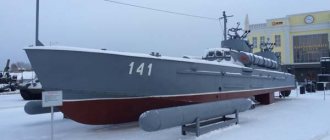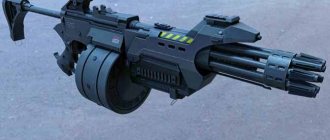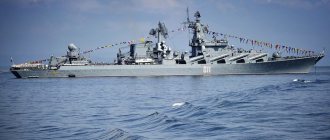History of construction[edit]
2008edit
On February 8, the first PRDK of project 21980 was laid down in the city of Zelenodolsk at OJSC Zelenodolsk Plant named after A. M. Gorky under serial number 981. The boat received the tactical number P-104.
2010edit
After completing the ZHI and GHI, in May, the P-104 PRDK was enlisted in the 105th brigade of ships guarding the water area of the Leningrad naval base of the Baltic Fleet, based in Kronstadt. And in May, in the workshop of the Zelenodolsk Shipyard, the second boat was laid down under serial number 982. The boat received the tactical number P-191, and was the first in the series to receive a ship's diving complex with a pressure chamber.
2011edit
File:International Maritime Defense Show 2011 (375-44).jpg P-104 PDRK during the Lenexpo 2011 salon
Novorossiysk
2012edit
Since the beginning of the year, testing of the P-191 PRDK has continued. May 5 The laying of the fourth boat under serial number 984 took place in Zelenodolsk. On June 16, the PRDKA P-349 was launched. On July 27, the fifth boat was laid down under serial number 985. And also in May, the laying of a boat took place in the city of Vladivostok. Thus, the plant in Vladivostok became the second enterprise in Russia building boats of Project 21980. In August, the laying of the next boat under serial number No. 8003 took place in Vladivostok. On September 3, the naval flag was raised on the PRDKA P-191, and the boat was enlisted in the Black Sea Fleet. On November 14, an acceptance certificate for the P-349 PRDKA was signed at the Novorossiysk naval base; the boat was also included in the Black Sea Fleet. In December, another prime mover was laid down at the Eastern Shipyard under serial number No. 8004 for the Pacific Fleet.
2013edit
On May 7, the next PRDK under serial number 986 was laid down at the Zelenodolsk plant named after A. M. Gorky. In April, the P-350 PRDK was launched and testing began. In June, the P-351 PRDK built in Zelenodolsk was launched. June 24 - launching of the first P-377 PRDK built at the Eastern Shipyard. On July 27, the P-356 PRDK, serial number 987, was laid down in Zelenodolsk. On August 22, with the completion of the GHI of the P-350 PRDK, an acceptance certificate for the boat was signed. On October 15, in the city of Makhachkala, an acceptance certificate was signed for the P-351 PRDK built for the Caspian Flotilla. On November 29, the P-420 PRDK, serial number No. 8003, was launched at the Eastern Shipyard.
2014edit
File:Rook on sea trials.JPG P-420 PDRC in Peter the Great Bay on October 24, 2014
February 23, May 30, July 4, August 22, September 25, October 6, October 9
2015edit
File: "P-351".jpg P-351 PDRC at the naval parade of the Caspian Flotilla in honor of the celebration of Russian Navy Day in Astrakhan, July 26, 2020
On January 12, the next PRDK under construction number 988 would have been laid at the Zelenodolsk plant. The P-191, P-349 and P-350 boats based on the Black Sea, in accordance with the order of the Russian Ministry of Defense dated February 16, 2015, received their own names “Cadet”, “Suvorovets” and “Cadet-Kirovets”. On March 17, the St. Andrew's flag was raised on the P-356 PRDK. On May 4, the P-104 PRDK arrived in St. Petersburg to participate in the naval parade dedicated to the 70th anniversary of the Victory. On May 7, the next laying of the boat took place in Zelenodolsk, serial number 989. On July 5, the P-191 PRDK took part in the 7th International Naval Salon "Lenexpo 2015". On July 15, a solemn ceremony of renaming the P-191, P-349 and P-350 boats took place in Novorossiysk. On September 15, the laying of the next PRDK under serial number 01223 took place.
2016edit
As of January 1, 2020, the Navy has 10 boats: one PRDC in the Baltic and Caspian Seas, 5 in the Black Sea, and 3 in the Pacific Ocean. 5 boats have been laid down and contracts have been signed for another 4 boats.
Notes
- Anti-sabotage boats "Grachonok" will be equipped with Chinese engines
- A series of anti-sabotage boats of Project 21980 PRDK "Grachonok"
- Tender (electronic auction) 91-1523810 dated 07/12/2013
- Falcon
- The anti-sabotage defense forces of the Pacific Fleet tested the Grachonok boat and Tethys Pro equipment
- The fifth “Rook” completed state tests in Makhachkala. 11/25/2013
- The lead boat of Project 21980 was given the personal name “Nakhimovets”. 02/27/2014
- The LenVMB boat is named after the Nakhimov School. 02/24/2014
- The laying ceremony of the 5th PRDK "Rook" of project 21980, serial number 985 took place on July 27, 2012 at the OJSC "Zelenodolsk Plant named after A. M. Gorky"
- Project 21980 anti-sabotage boat
- The Project 21980 boat will be laid down at the Zelenodolsk plant named after Gorky
- Laying down the seventh in the series of Project 21980 boats. 07/27/2013
- The fifth boat of Project 21980 has successfully completed state tests. 10/16/2013
- State contracts of the Russian Ministry of Defense dated January 20, 2014 3/1/1/0014/GK-14-DGOZ and 3/1/1/0015/GK-14-DGOZ
- ↑ 123
Construction of anti-sabotage boats "Grachonok" - The anti-sabotage forces of the Pacific Fleet this year will include two Rooks. 02/27/2014
- Anti-sabotage exercises were held in the Pacific Fleet
- The eighth "Rook" was launched at the shipyard of the Zelenodolsk plant named after. A.M. Gorky"
- The third "Rook" for the Pacific Fleet was launched. 07/04/2014
- The anti-sabotage boat "P-417" of the Pacific Fleet was named "Yunarmeets of Kamchatka" : Ministry of Defense of the Russian Federation
- The sixth "Rook" successfully completed state tests
- The seventh "Rook" began the transition to the Black Sea. 08/14/2014
- The seventh "Rook" successfully completed state tests
- Press release on the occasion of the laying of the eighth of the Project 21980 boat series
- Results of the work of the Zelenodolsk plant named after. A.M. Gorky in 2014.
- "Zelenodolsk Plant" will lay down the ninth "Rook"
- Acceptance certificates have been signed for two “Rooks”
- https://function.mil.ru/news_page/country/ [email protected]
- The newest anti-sabotage boat P-433 of the Grachonok project arrived in Sevastopol
Description of the design of project 21980 “Rook”
The anti-sabotage boat "Grachonok" is a single-deck ship with a fairly developed superstructure and transom stern. It is equipped with a crane for loading operations. The crew of the boats of this project consists of eight people. The ship's autonomy is five days.
In 2014, due to Western sanctions imposed on Russia, supplies of German engines were stopped. They were replaced with Chinese counterparts manufactured by Henan Diesel Engine Industry Co.LTD. Deliveries were made through the Russian one. The new power plant includes two TBD620V12 engines, two reverse gearboxes and couplings.
In March of this year, information appeared in the Russian media that both Chinese engines failed during the first test. Because of this, penalties in the amount of 750 thousand rubles were imposed on the Russian subcontractor Marine Propulsion Systems. True, it is now not entirely clear what engines the new ships will be equipped with.
The ship's equipment includes the MR-231 "Pal" radar, which is designed for navigation safety and provides all-round radar coverage. This radar can automatically track 50 targets over a long period of time and has a built-in system for identifying the nationality of the target. Information about the surrounding environment is superimposed on a digital map of the ship's navigation area.
Also, the equipment of the boats of this project includes an automated communication complex AKS R-779-9, a multifunctional complex for illuminating near-air and surface conditions MTK-201M3, an integrated bridge system IMS “Mostik-21980”, a hydroacoustic station for detecting underwater sabotage forces and means MG- 757 "Anapa".
The Anapa hydroacoustic station can detect combat swimmers at distances of 300 meters in a 360-degree sector. The station's antennas are located on a special device that extends from the ship's hull. During the tests, the station was used to study the underwater environment of the harbor, the bottom and the water column. When moving at a speed of about six knots, various objects on the bottom, quay walls, and anchor chains were clearly observed at distances of up to 300 meters.
Based on the results of state tests, the Kalmar complex was modernized; in the future, they plan to create a new, more advanced, uninhabited underwater descent vehicle for boats of this project.
Despite its rather modest size, the Rook boat is seriously armed. On board there are four portable Igla missile systems for combating low-flying air targets, as well as a 14.5 mm machine gun mount. However, the main weapon designed to fulfill the main task of the boat - fighting enemy swimmers - are anti-sabotage grenade launchers. There are two types of them on board the Grachonok: a ten-barreled, 55 mm caliber, remote-controlled grenade launcher 98U and a portable hand-held double-barreled anti-sabotage grenade launcher DP-64 Nepryadva.
The 55-mm grenade launcher ensures the defeat of underwater saboteurs at distances of up to 500 meters and depths of up to 40 meters. The RG-55M high-explosive grenade, which is used by 98U, has a guaranteed damage radius of up to 16 meters from the entry point. This weapon works in conjunction with the Anapa sonar station, which is used for aiming.
DP-64 "Nepryadva" is used to solve similar problems; it can hit underwater targets at distances of 400 meters and a depth of 40 meters. The grenade launcher's ammunition provides a damage radius of 14 meters.
Based on the foregoing, we can conclude that Project 21980 boats, despite their rather modest dimensions (displacement 138 tons, length 31 meters, draft 1.85 meters), are capable of solving a whole range of combat missions and confidently protecting bases from sabotage and terrorist threats.
Author of the article:
Egorov Dmitry
I am interested in military history, military equipment, weapons and other issues related to the army. I love the written word in all its forms.
kolpino_podlodka.jpg
In the photo: “Kolpino”
These are the famous “Varshavyankas” of the modified project 636.3. The submarines transferred to the fleet last year brought their Black Sea group to six units. A powerful force considering the excellent performance of these submarines. In the West, they received the nickname “Black Hole” for their extremely low noise level, comparable to the background of the sea.
“Varshavyankas” are capable of detecting a target much earlier than they themselves are noticed. Four of the six TAs are loaded with Caliber anti-ship missiles and have 18 torpedoes on board.
The submarines have a significant underwater displacement - almost four thousand tons. They reach a speed of 17 knots and are capable of going to a depth of 300 meters.
Each one costs about 16 billion rubles. A good price, especially considering how dangerous the silent Varshavyankas armed with Caliber can be for the enemy in the Black Sea.
Sea minesweeper "Alexandrite"
Design Features
Layout diagram of the "Mongoose" ships
The basis of the design of the "Mongoose" boat is a V-shape made with external contours. This option is considered standard for all planing boats, as it provides optimal performance and hydrodynamic resistance for a smoother ride.
Boat hull
The boat's hull is made of a modern alloy of aluminum and magnesium, which makes the structure lighter and stronger. The V-shape, combined with good streamlining, ensures optimal planing, high speed and maneuverability of the vessel. It is these qualities that make it in demand in patrols and special operations.
Engine
The Mongoose power plant consists of two diesel gear units (DRA). Initially, domestic diesel engines M470M with 12 cylinders were used in construction. Later they were replaced by four-stroke German units 10V 2000 M93 with 10 cylinders. However, since 2020, as part of the import substitution program, domestic M470MK engines have returned.
The new unit is produced by the Zvezda machine-building enterprise; it also has 12 cylinders and is equipped with an air compressor. The total power of two such engines is 2600 hp. With. Thanks to this indicator, the vessel is capable of reaching speeds of up to 50 knots, approximately 92 km/h. The most economical fuel consumption was recorded at a speed of 36 knots (67 km/h).
On-board electronics
"Mongoose" of the transport police
The ship's onboard electronics are represented in three areas: navigation equipment, communications and surveillance equipment. The first includes:
- integrated navigation system kit;
- magnetic compass "Azimuth" 90-1;
- gyrocompass PGM-C-009.
Surveillance and communication means are represented by the following equipment:
- satellite communications station Inmarsat Sailor 500 Fleet Broadband;
- MF/HF radio with digital selective calling (DSC) and Sailor 6300 telex;
- ultra-short wave (VHF) radio with DSC Sailor 6222;
- satellite station Inmarsat-C Sailor 6110 mini-C;
- NAVTEX NX-700A receiver;
- emergency radio beacon of the COSPAS-SARSAT system TRON 40S;
- two TRON SART radar transponders;
- three portable VHF radios SP3520;
- means of intra-ship communication and broadcasting.
Bottom of the ship
Like the hull, the bottom of the boat is made of modern alloys. The outside is provided with two-layer protection from a protective electrochemical and paint coating. A special anti-corrosion coating was used. This technology not only provides better gliding, but also significantly reduces wear on the hull and bottom of the boat during operation.
6 compartments
The internal layout of the vessel divides it into 6 compartments. Their location allows you to comfortably accommodate 6 crew members - there are two single cabins, a forecastle, and a wardroom combined with a galley. The engine room is located at the rear of the boat. The entire layout is designed in such a way that if one or two compartments are flooded, the ship can remain afloat.
History of creation
Coast Guard Mongoose
The project of a modern patrol boat was developed in the second half of the 1990s. The development was carried out by the Almaz design bureau in St. Petersburg. The project was initially focused on the needs of the border service, as well as application in the Ministry of Emergency Situations and law enforcement agencies. The main goal was to replace the Vostok boat, the technical characteristics of which were beginning to become outdated.
Serial production of the new ship began in 2000 at the shipbuilding plant. The first samples entered service with the Border Troops, after which modifications were produced for other departments.
In 2013, Project 12150 Mongoose patrol boats were modified by order of the Russian Navy. The boat received an enlarged superstructure and a modified interior layout. A machine gun mount with remote control capability was also added. As a result, the new version improved all the characteristics of the base model.
Taking into account developments for various departments, there are several modifications of this vessel:
- 12150M - multi-purpose search and rescue ship;
- 12150A - anti-sabotage patrol vessel for the Russian Navy;
- 12150В - a boat with missile weapons on board;
- 12151 - a boat without its own weapons, designed for the Ministry of Emergency Situations.






